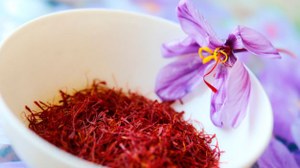Through millennia saffron was not only prized as an ingredient for delicious food, but it was also highly prized as a dye stuff and medicine. The oldest known example of the use of saffron (as a paint) is in a 50,000 year old cave art illustrating beasts, in modern day Iraq. In ancient Persia, saffron (Crocus sativus 'Hausknechtii') was cultivated at Derbena and Isfahan in the 10th century BC. It was used as a brilliant yellow dye in royal Persian carpets as well as funeral shrouds and also as perfume, medicine and ritual offerings to deities by ancient Persian worshippers. Saffron threads were even scattered across beds and mixed into hot teas as a cure for melancholy. Foreign travellers to Persia, however, were widely suspicious of it as they believed it to be a drugging agent and an aphrodisiac, so much so that travellers were fore-warned not to eat the saffron-laced Persian cuisine. In addition, Persian saffron was dissolved in water with sandalwood to use as a body wash after heavy work and perspiration under the hot Persian sun. Its medicinal qualities were so revered that even Alexander the Great used saffron sprinkled in his warm bath water believing, like Cyrus the Great before him, that it would heal his many wounds and his faith in saffron grew with each treatment. He even recommended saffron baths for the ordinary men under him. The Greek soldiers, taken with saffron's perceived curative properties, continued the practice after they returned to Macedonia. From Persia it spread to many different regions where each starting growing its own variant, but Iranian saffron is still regarded as the best in quality today.
So what about saffron makes it so expensive? Firstly, the spice comes from the flower of Crocus sativus, commonly known as the "saffron crocus" and is a triploid. It can’t grow in the wild or reproduce without human intervention. Secondly, the gorgeous purple flower is painstakingly propagated and the threads harvested by hand only on the morning it blooms. The more careful the cultivation, the higher the price. The threads are then collected and dried to be used mainly as a seasoning and colouring agent in food. Thus to grow and cultivate this plant is a long and arduous process that require many man hours to succeed.
Gonabad is the main saffron growing region in Iran and it is a dry region with almost no rainfall. To solve the problem of providing water for the saffron crocus, the ancient Persians thought of an ingenius idea to ensure sufficient water supply to this very popular and exclusive spice and other agrecultiral endeavours, they built qanats (a gently sloping underground channel that transports water from an aquifer or water well to surface for irrigation and drinking.
Qanats still create a reliable supply of water for human settlements and irrigation in hot, arid, and semi-arid climates today). The Qanats of Gonabad is ofcourse one of the oldest and largest qanats in the world built between 700 BC to 500 BC, and is still in use today. This site was officially added to the UNESCO's list of World Heritage Sites in 2016 with several other qanats under the World Heritage Site name of "The Persian Qanet”.
In the time of the Achaemenid Dynasty there was a ruling that someone who succeeded in constructing a qanat and bringing groundwater to the surface in order to cultivate land, or in renovating an abandoned qanat, would not need to pay the government any taxes for up to 5 generations after him. Thanks to this engineering feat the cultivation of Persian saffron succeeded and grew through the ages to such an extent that Iran is now the largest producer of saffron in the world, together with pistachio, berberis (zereshk), caviar, stone fruit and berries.



